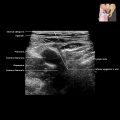KEY FACTS
Imaging
- •
Multiple nodules with bilateral diffuse involvement
- •
Solid nodules most often isoechoic; 5% hypoechoic
- •
Nodules are sharply defined with haloes but may conglomerate
- •
Heterogeneous internal echo pattern: Solid/cystic portions, internal debris, septa, “spongiform” nodules
- ○
Cystic component due to degeneration, hemorrhage, or colloid within nodule
- ○
- •
Dense shadowing calcification (curvilinear, dysmorphic, coarse)
- •
Nodules with comet-tail artifact; highly suggestive of colloid nodule (may mimic microcalcification)
- •
Background thyroid may be heterogeneous
- •
Color Doppler: Peripheral > intranodular vascularity
- ○
Septa and intranodular solid portions are avascular (organizing blood, clot)
- ○
Top Differential Diagnoses
- •
Papillary and follicular carcinoma
- •
Anaplastic and medullary thyroid carcinoma
Clinical Issues
- •
Incidence of sporadic multinodular goiter (MNG): ~ 5% in US
- •
Sporadic goiter has no specific age incidence, F:M = 2-4:1
- •
Most asymptomatic and euthyroid
- •
Can become hyperthyroid or hypothyroid
- •
Symptoms related to mass effect: Airway compression, hoarseness, dysphagia, and superior vena cava syndrome
Scanning Tips
- •
Change transducer frequency to evaluate colloid, calcification and cystic components
- •
Use curvilinear transducer if thyroid is too large for linear transducer
- •
Look for suspicious nodules
 . The trachea
. The trachea  is displaced to the right.
is displaced to the right.










